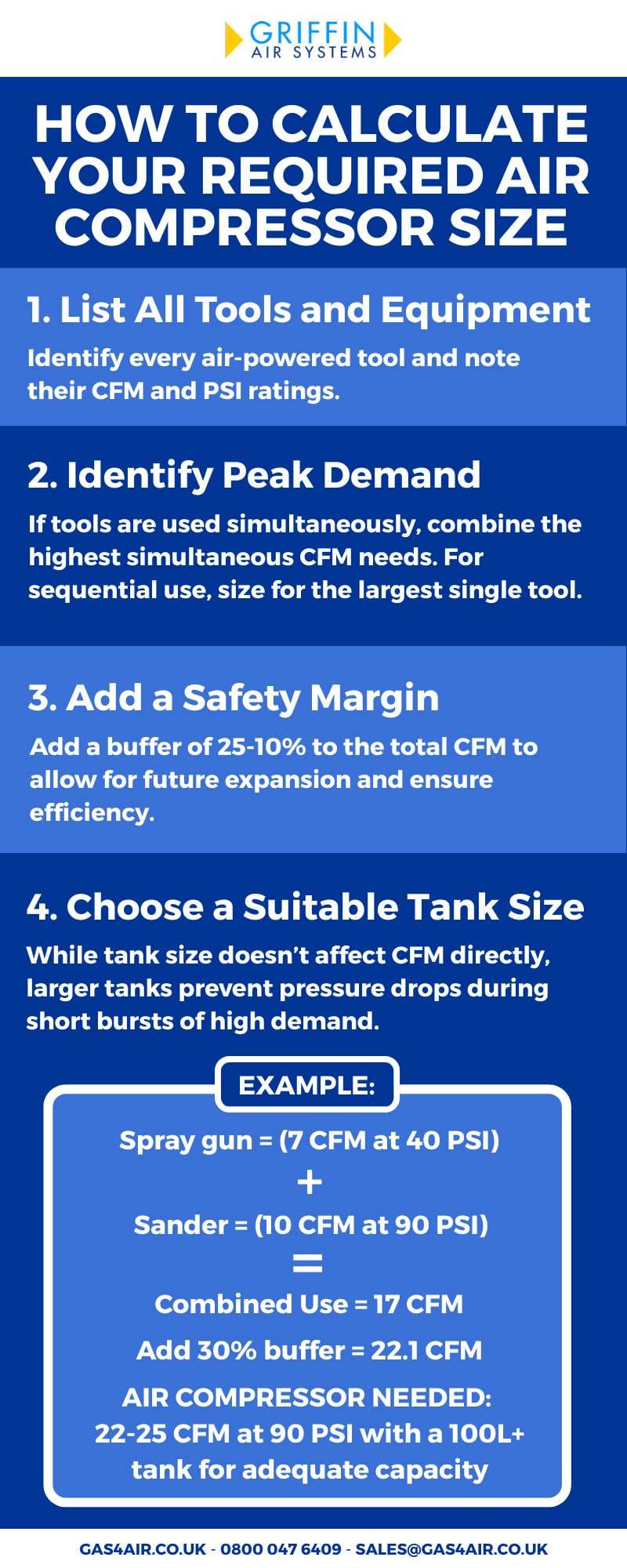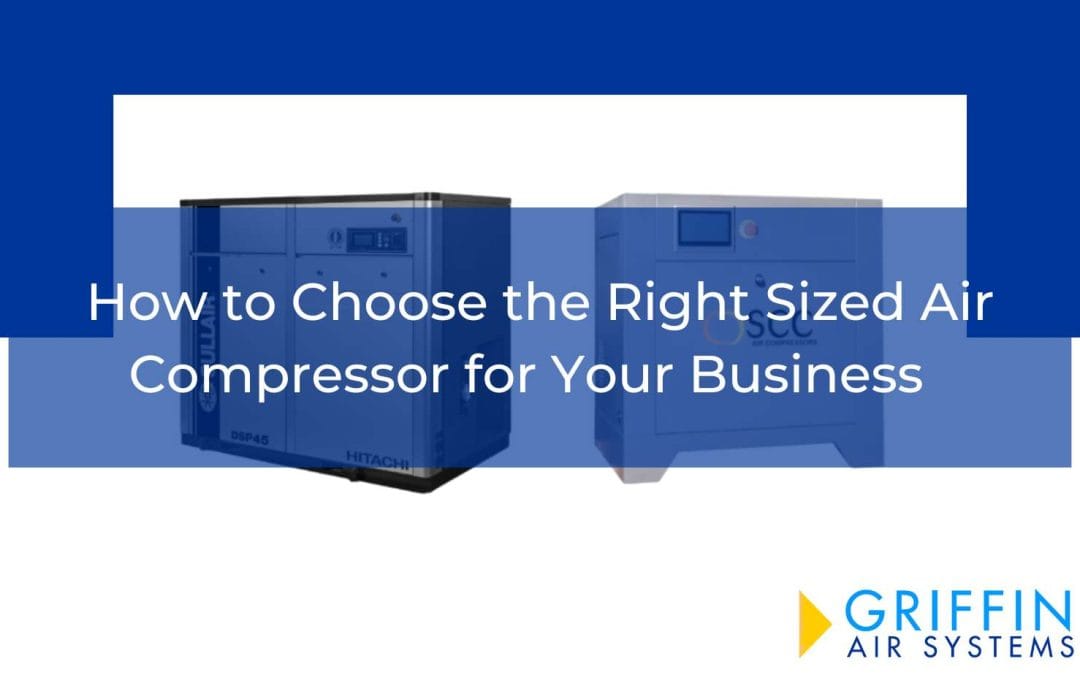When it comes to investing in an air compressor for your business, size truly matters. Choosing the right sized air compressor is essential to maximise efficiency, minimise energy costs, and ensure your tools or machinery run smoothly. But how do you know if you need a small air compressor for basic operations or a large air compressor for industrial demand?
Whether you’re operating a workshop, manufacturing facility, garage, or construction site, understanding air compressor sizing is critical. In this guide, we’ll explore everything you need to consider when selecting the best compressor for your needs.
- What Is Air Compressor Sizing?
- Why Air Compressor Size Matters
- 4 Things to Consider When Choosing Your Air Compressor Size
- Small vs Large Air Compressors: Pros and Cons
- How to Calculate Your Required Air Compressor Size
- Key Takeaways for Air Compressor Sizing
- Frequently Asked Questions
What is Air Compressor Sizing?
Air compressor sizing refers to selecting a compressor with the appropriate capacity, pressure, and tank size to meet the demands of your equipment and workflow.
The three most important figures are:
- CFM (Cubic Feet per Minute): Measures airflow or how much air the compressor delivers.
- PSI (Pounds per Square Inch): Indicates the pressure output.
- Tank Size: Measured in litres, which helps manage demand during peak usage.
These measurements collectively determine how efficient, powerful, and suitable the unit will be for your application.
Why Air Compressor Size Matters
Selecting the right size air compressor isn’t just about matching power—it’s about ensuring your business runs efficiently, reliably, and cost-effectively. An incorrectly sized unit can affect everything from tool performance to your bottom line.
Undersized Compressors
When a compressor is too small for the job, it struggles to keep up with demand. This leads to:
- Frequent cycling, which causes unnecessary wear and tear
- Inconsistent air pressure, reducing the effectiveness of tools and machinery
- Reduced productivity, as equipment may pause or underperform during tasks
Oversized Compressors
Bigger isn’t always better. A compressor that’s too large for your needs can:
- Consume more energy than necessary, inflating your electricity bills
- Cycle on and off more frequently, causing potential maintenance issues
- Take up more space, which can be inefficient or impractical in smaller work environments
Correctly Sized Compressors
A properly sized compressor hits the sweet spot by:
- Delivering the right amount of airflow and pressure for your specific tools and usage
- Minimising energy consumption, leading to lower operational costs
- Extending the life of both the compressor and connected equipment, thanks to reduced strain and optimal performance
Ultimately, the right size means better reliability, smoother operations, and long-term savings—something every business can benefit from.
4 Things to Consider When Choosing Your Air Compressor Size
When working through an air compressor size guide, you’ll want to consider the following:
1. Type of Work or Industry
Different sectors require different levels of air power. For example:
- Light-duty use (e.g., tyre inflation, airbrushing): small air compressor
- Medium-duty use (e.g., powering nail guns, painting): mid-size compressor
- Heavy-duty or industrial (e.g., running multiple air tools or machinery): large air compressor
2. Number of Tools or Users
More tools or simultaneous users increase CFM requirements. List out every air tool and its CFM rating at the required PSI, then add 25–30% buffer for efficiency.
3. Duty Cycle
How often and how long will your compressor run? A 100% duty cycle is ideal for continuous operation, while lower percentages suit intermittent use.
4. Environment and Location
For mobile use, portability and size are essential. Stationary compressors can be larger with bigger tanks, suitable for workshops or factories.
Small vs Large Air Compressors: Pros and Cons
Understanding whether a small air compressor or large air compressor suits your setup depends on your requirements:
| Compressor Size | Pros | Cons |
| Small Air Compressors |
|
|
| Large Air Compressors |
|
|
How to Calculate Your Required Air Compressor Size
Here’s a step-by-step method to size your air compressor correctly:
Step 1: List All Tools and Equipment
Identify every air-powered tool and note their CFM and PSI ratings.
Step 2: Identify Peak Demand
If tools are used simultaneously, combine the highest simultaneous CFM needs. For sequential use, size for the largest single tool.
Step 3: Add a Safety Margin
Add a buffer of 25–30% to the total CFM to allow for future expansion and ensure efficiency.
Step 4: Choose a Suitable Tank Size
While tank size doesn’t affect CFM directly, larger tanks prevent pressure drops during short bursts of high demand.
For example let’s say you operate:
- A spray gun (7 CFM at 40 PSI)
- A sander (10 CFM at 90 PSI)
Combined use = 17 CFM.
Add 30% buffer = 22.1 CFM.
Choose a compressor with at least 22–25 CFM at 90 PSI, with a 100L+ tank for adequate capacity.
Key Takeaways for Air Compressor Sizing
- CFM and PSI are the most important figures in air compressor sizing.
- Choose a small air compressor for light, portable, and occasional use.
- Opt for a large air compressor if running multiple tools or operating in industrial settings.
- Don’t overlook duty cycle, tank size, and space requirements.
- Always include a buffer to future-proof your investment.
At Griffin Air Systems, our team can help you assess your needs and recommend the perfect air compressor.
Air Compressor Size FAQs
What size air compressor do I need for my workshop?
This depends on how many tools you plan to use and their CFM/PSI requirements. For most workshops, a compressor offering 10–20 CFM at 90 PSI with a 50L–150L tank is a good starting point. View our new air compressors for suitable models.
Can I use a small air compressor for industrial work?
A small air compressor is not designed for continuous use or multiple tools. Industrial environments often require large air compressors with higher CFM, large tanks, and stronger durability.
How do I know if my air compressor is too small?
If your tools underperform, pressure drops frequently, or the compressor cycles constantly, it’s likely undersized. In that case, upgrading to a larger unit may be the best long-term solution.
Choose The Perfect Sized Air Compressor with Griffin Air Systems
Choosing the correct air compressor size is vital for smooth operations, tool longevity, and energy savings. By carefully considering your tool demands, workspace, and long-term needs, you can find the perfect fit—whether that’s a small air compressor or a large, high-capacity system.
Not sure where to start? Contact Griffin Air Systems for personalised advice or explore our full range of new air compressors.
Related Articles
- Energy Efficiency and Air Compressors: Saving Money and the Environment
- Air Compressor Maintenance 101: Keeping Your Machine Running Smoothly
- Troubleshooting Common Air Compressor Problems


